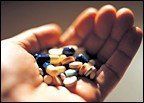Some doctors thrive in a personality-based clinic and have a loyal following no matter what services or equipment they offer, but for most chiropractic offices who are trying to grow and expand, new equipment purchases help us stay relevant and continue to service our client base in the best, most up-to-date manner possible. So, regarding equipment purchasing: should you lease, get a bank loan, or pay cash?
A Prescription for Disaster
In November 2003, the Knight-Ridder news service conducted an investigation of a phenomenon known as "off-label prescribing," in which medical doctors write prescriptions for drugs for uses other than those approved by the Food and Drug Administration. Based on its analysis, Knight-Ridder estimated that doctors write up to 115 million prescriptions per year for off-label or unapproved uses, and that between 8,000 and 80,000 people may suffer serious adverse reactions as a result of taking an off-label prescription.1

A new analysis of prescription drug use has found that the number of prescriptions written for off-label use is even higher. According to the analysis, published in the May 8th issue of the Archives of Internal Medicine, more than one in five prescriptions written in the United States - as many as 173 million each year - are for unapproved or unproven uses, and as many as one in seven drug prescriptions are written for reasons that have "little or no scientific support."2
Off-label prescribing is the term for a drug that is prescribed for a use other than the drug's approved use on its FDA label. For example, a doctor might prescribe a drug that is approved by the FDA to treat one condition, such as cancer, for another condition, such as hypertension. Changing a drug's approved dosage or duration of treatment, or prescribing a drug approved by the FDA for adults and giving it to a child, are other examples of off-label prescribing.
Once a drug has received approval from the FDA to be marketed for the treatment of at least one specific ailment, it can be legally prescribed to treat other ailments. The FDA does not require drug manufacturers to obtain approval for all conditions for which a particular drug may have value. In addition, while medical doctors normally are required to obtain informed consent from their patients before providing prescribed treatments, no law in any state specifically requires a doctor to inform his or her patient that a drug is being prescribed for off-label use.
The American Medical Association has been an ardent supporter of off-label prescribing. According to AMA policy H.120-988, "The AMA confirms its strong support for the autonomous clinical decision-making authority of a physician and that a physician may lawfully use an FDA approved drug product or medical device for an unlabeled indication when such use is based upon sound scientific evidence and sound medical opinion."3 In March 2005, Dr. Cecil Wilson, a member of the AMA board of trustees, testified before the U.S. Senate Committee on Health, Education, Labor and Pensions regarding drug safety recommendations and stated that the FDA should "ensure that physicians' ability to prescribe drugs off-label not be impeded."4
In the Archives of Internal Medicine analysis, researchers examined the prescription patterns for 160 drugs: the 100 most popular drug medications in the U.S., according to the 2001 National Disease and Therapeutic Index, or NDTI, and 60 additional medications selected at random. Altogether, the drugs in the analysis accounted for approximately 56 percent of all estimated prescription drug use in 2001. The researchers then compared each prescription, or "drug mention," with the top 40 diagnoses associated with each medication, to determine whether the prescriptions fell into one of three categories: FDA approved; off-label, but with strong scientific support for the off-label use; or off-label, with limited or no scientific support.
Analysis of the NDTI data found that a total of 725 million drug mentions were written for the 160 drugs used in the sample in 2001. While the majority of the drug mentions were for FDA-approved indications, a substantial number (estimated at 150 million, or 21 percent) "lacked FDA approval for the condition they were used to treat." Furthermore, a full 15 percent of the drug mentions in the analysis "lacked scientific evidence for the indication they were used to treat."
Off-label prescriptions were most common among two classes of drugs: cardiac medications (such as antianginals, antiarrhythmatics and anticoagulants) and anticonvulsants. For both classes of drugs, 46 percent of all prescriptions for these drugs were considered off-label prescriptions. In terms of sheer numbers, the most off-label prescriptions were written for antimicrobials (35.5 million) and drugs for "psychiatric therapies" such as antidepressants, anxiolytics and antipsychotics (17 million). Combined, these two classes accounted for more than one third of all off-label prescriptions in the analysis.
The drug with the highest proportion of off-label prescriptions (83 percent) was gabapentin, an anticonvulsant medication approved to treat certain kinds of epileptic seizures, but which also is used with other drugs to treat nerve pain caused by the herpes virus. Furthermore, only 20 percent of the off-label prescriptions written for gabapentin were backed by strong scientific support for such uses - an important fact when one considers that in 2004, gabapentin's manufacturer pleaded guilty to two counts of criminal fraud and agreed to pay a settlement of more than $430 million to resolve criminal charges and civil liabilities. Other drugs with disproportionate off-label prescriptions included an antidepressant, amitriptyline hydrochloride (81 percent), and the oral version of dexamethasone, a steroid.
"Using data from a nationally representative survey of office-based physicians, we found that about 21 percent of all estimated uses for commonly prescribed medications were off-label, and that 15 percent of all estimated uses lacked scientific evidence of therapeutic efficacy," the authors of the study wrote. They added that the degree of off-label use "varied widely among specific medications and drug classes."
While some off-label prescriptions were written based on what appeared to be legitimate evidence, the vast majority of these prescriptions were not. According to the authors, "No more than 30 percent of the off-label practices we observed were supported by strong scientific evidence." Although they were unable to determine the causes that lead to off-label prescriptions, they used the example of gabapentin to suggest the marketing tactics of pharmaceutical companies may be a leading factor.
"We need to know more abut the factors that produce off-label medication use," the authors stated. "Although our data do not allow us to link off-label medication use to promotional activities for specific off-label indications, the high degree of off-label use observed for gabapentin suggests the need to better understand the determinants of off-label medication use, including the potential influence of pharmaceutical marketing."
While the authors of the Archives study did not examine the financial impact of off-label prescriptions, the Knight-Ridder investigation of 2003 estimated that off-label sales of the drugs included in its analysis was approximately $12.9 billion. This figure accounted for nearly one-quarter of those drugs' retail sales. However, the Knight-Ridder analysis looked at off-label use for only 45 drugs, and excluded cancer treatments and pediatric off-label uses. The'Archives analysis, on the other hand, examined off-label prescription use for 160 medications. If the Knight-Ridder statistics are used as a benchmark and extrapolated to the thousands of prescription drugs currently sold in the United States, one is left to wonder at the financial and human costs of off-label prescribing in terms of wasteful medication use, unnecessary insurance billing and paperwork, and compromised patient safety.
References
- Risky RX: a Knight-Ridder investigation.
- Radley DC, Finkelstein SN, Stafford RS. Off-label prescribing among off-based physicians. Archives of Internal Medicine, May 8, 2006;166:1021-1026.
- American Medical Association policy #H.120-988: patient access to treatments prescribed by their physicians. Available at www.ama-assn.org.
- AMA testifies at Senate drug hearing. March 3, 2005. Available online.
- www.fda.gov/cder.



